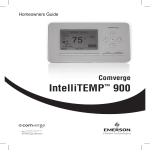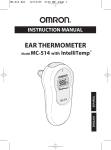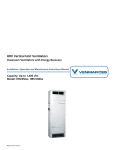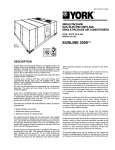Download White Rodgers 1F71 Specifications
Transcript
IntelliteMp™ 900 INStAllAtION INStRUCtIONS Operator: Save these instructions for future use! FAIlURe tO ReAd ANd FOllOW All INStRUCtIONS CAReFUllY BeFORe INStAllING OR OpeRAtING tHIS CONtROl COUld CAUSe peRSONAl INJURY ANd/OR pROpeRtY dAMAGe. deSCRIptION This IntelliTEMP™ thermostat replaces the following thermostats: • HeatPump(NoAux.orEmergencyHeat) • HeatPump(upto4H/2C) • SingleStageHeat&CoolingSystems • UptoTwoStageHeatorTwoStageCool • HeatOnlySystems • StandardCentralAirConditioning • Hydronic(HotWater)ZoneHeat–2Wires (ButnotHydroniczoneheatwith3wires) SpeCIFICAtIONS Electrical Rating: Input-Hardwire ................................................... 20 to 30 VAC TerminalLoad ........................................................... 1.5Aperterminal,2.0Amaximumallterminalscombined Setpoint Range ......................................................... 45to99°F(7to37°C) OperatingAmbient .................................................... 32°Fto+105°F(0to+41°C) OperatingHumidity ................................................... 90%non-condensingmax. Shipping Temperature Range ................................... -40to+150°F(-40to+65°C) ! CAUTION to prevent electrical shock and/or equipment damage, disconnect electric power to system at main fuse or circuit breaker box until installation is complete. CONteNtS AtteNtION: MeRCURY NOtICe This product does not contain mercury. However, this productmayreplaceaproductthatcontainsmercury. Mercury and products containing mercury must not be discarded in household trash. Do not touch any spilled mercury. Wearing non-absorbent gloves, clean up any spilledmercuryandplaceinasealedcontainer.Forproper disposal of a product containing mercury or a sealed containerofspilledmercury,placeitinasuitableshipping container. Refer to www.thermostat-recycle.org for locationtosendproductcontainingmercury. Description .......................................................................1 Specifications ...................................................................1 Installing the Thermostat ..................................................2 Wiring Chart .....................................................................6 Description of Installation Menu Options .........................7 ! WARNING do not use on circuits exceeding specified voltage. Higher voltage will damage control and could cause shock or fire hazard. pARt NO. 37-7224B Replaces 37-7224A 1211 INSTALLATION Required Parts • • • Thermostat (1) Wall anchors (2) Mounting screws (2) Required Tools Quick Guide 1) Remove the old thermostat • Turn off power at the breaker. To prevent electrical shock and/or equipment damage, disconnect electric power to system at main fuse or circuit breaker box until installation is complete. • • 2) 3) 4) 5) Remove cover from old thermostat to expose wires. Identify each wire to corresponding terminal and disconnect. • Remove old thermostat from wall, making sure that thermostat wires do not fall back into wall opening. Mount the new thermostat • Feed thermostat wires through thermostat hole. • Feed antenna wire through wall opening. • Wire new thermostat. • Turn on power at breaker. Configure the thermostat Check thermostat operation Verify Communications The sections that follow provide detailed instructions for completing these steps. Step 1: Remove the Old Thermostat Thermostat Components The standard heat/cool thermostat normally consists of three basic parts: 1. Cover. 2. Base, which you can remove by loosening all screws. 3. Switching sub-base or Mounting base, which you can remove by unscrewing the mounting screws that hold it on the wall or adaptor plate. Remove the old thermostat: 1. Remove the front cover of the old thermostat. 2. With wires still attached, remove wall plate from the wall by unscrewing it. If the old thermostat has a wall mounting 2 You may want to wrap the wires around a pencil to keep them from falling back into the wall. Y + R + G + + C + W G ! CAUTION NOTE W Flat blade screwdrivers – 1 large and 1 small Hand or power drill with 3/16 inch drill bit Wire strippers Level (optional) Important: Do not let wires fall back into the wall. C • • • • plate, remove the thermostat and the wall mounting plate as an assembly. 3. Identify each wire attached to the old thermostat as shown in the diagram below. Before removing wires from old thermostat’s switching sub-base, label each wire with the letter on the old thermostat. Ignore wire colors and use the letter designation only. 4. Disconnect the wires from the old thermostat one at a time. Y Before you begin to install your IntelliTEMP™ thermostat: • Read these instructions thoroughly. • Check the package from your thermostat to make sure you have all of the required parts (see below). • Assemble the required tools (see below). R Pre-Installation Checklist + Figure 1. Thermostat wires with labels Step 2: MOUNT THE NEW THERMOSTAT ! CAUTION Take care when securing and routing wires so they do not short to adjacent terminals or rear of thermostat. Personal injury and/or property damage may occur. To prevent personal injury and/or property damage, contact Customer Service at your utility company before attempting any step in the installation process that you are unsure about how to perform. Mount the new thermostat: 1) Unpack the thermostat and separate the mounting plate from the thermostat. Remove the packing material from the thermostat. Gently pull the thermostat straight off of the base: hold the thermostat from the back by the lower corners with one hand, and pull the mounting plate off with the other hand. NOTE Forcing or prying on the thermostat will cause damage to the unit. 2) Feed thermostat wires through rectangular hole between the terminal blocks in the thermostat mounting plate. 3) Connect wires to the thermostat mounting plate. Connect wires beneath terminal screws on base. The photo on next page shows the location of the wire terminals in the IntelliTEMP™ 900. There are two sets of terminals on either side of the hole the wires are fed through. Each terminal is labeled with a letter or a letter with a number (O, B, R, etc.). INSTALLATION Connect wires as follows: • Strip insulation about 3/8 inch from end of wire. • Feed thermostat wires through rectangular hole in the thermostat mounting plate. • Locate the terminal that the wire needs to connect to. Use the Wiring Chart on page 6. • Bend the wire slightly, insert the wire between contact plates, and tighten the screw down onto the wire. For full details on where to connect each wire, see “Wiring Chart” on page 6. 7) Mount thermostat mounting plate. Fasten mounting plate loosely to wall using two mounting screws in mounting holes. Wire terminals. Insert wires here Mounting holes Feed wires through this hole 4) Mark mounting hole locations. Place thermostat mounting plate over hole in the wall and mark mounting hole locations (see below) using the mounting plate as a template. Mounting holes 5)Drill holes. Move mounting plate out of the way. Drill mounting holes using a 3/16 inch drill bit. 6) If device has wire, uncoil antenna wire and feed through wall opening. The white antenna wire will be coiled up on the back of the thermostat. Uncoil the wire (as shown below) and feed it through the wall opening. This antenna wire is used to communicate with the thermostat. If desired, place a level against bottom of the mounting plate and adjust until level before tightening screws. (Leveling is for appearance only and will not affect thermostat operation.) If you are using existing mounting holes, or if the holes drilled are too large and do not allow you to tighten base snugly, use plastic wall anchors to secure sub-base. Push excess wire into the wall and plug the hole with a fire resistant material (such as fiberglass insulation) to prevent drafts from affecting thermostat operation. 8) Fasten Thermostat to Mounting plate The IntelliTEMP™ is designed with a quick connect feature between the thermostat unit and mounting plate. When installing the thermostat onto the mounting plate, make sure the retention tabs on the mounting plate are in line with Retention slots Retention tabs Uncoil wire as shown and feed through wall opening 3 INSTALLATION the retention slots in the thermostat (see previous page). Gently press the thermostat onto the mounting plate until you hear the retention tabs make a clicking sound and the thermostat is securely fastened to the mounting plate. If the thermostat does not easily click onto the mounting plate, be certain not to press with excessive force or else damage could occur to the thermostat and/or mounting plate. 9)Turn power back On at breaker. When power is applied, verify the IntelliTEMP™ 900 thermostat powers up and begins to display the room temperature. Step 3: configure the new thermostat Configure the thermostat: 1. Press the SYSTEM button until the system mode displays OFF. 2. Simultaneously press and hold the and buttons to enter the Installation Menu. First screen asks for confirmation to enter the installation menu. Once confirmed, the display will show the first level of the Installation Menu. 3. While in the Installation Menu: and buttons scroll the cursor up and down • the respectively • The DONE softkey will confirm changes saved and go back one menu level. • The HOME softkey exits the installation menu back to the IDLE screen (NOTE: When the HOME softkey is pressed, any changes made on the current menu item are not saved). • The button selects the highlighted menu item • The DONE softkey goes back one menu level if no changes were made. 4. To exit the menu and return to the program operation, press HOME (when available). If no keys are pressed within two minutes, the thermostat will revert to normal operation. NOTE It is important to select the proper setting for the first item on the configuration menu which specifies the type of HVAC system. Installation Menu Options The installation menu table summarizes the configuration options. For more details on each Installation Menu option, see “Description of Installation Menu Options” on page 7. Menu Name Submenu Press or to Select Other Options (Defaults in BOLD) Comments HVAC Equipment Setup Outdoor Indoor Thermostat Setup Compressor Lockout O/B Configuration Thermostat Data Firmware: Hardware Model: S/N: Communications Setup Device Information WAN Interface 4 Air Conditioner Air Conditioner Heat Pump Heat Pump Heat Pump Heat Pump None Air Handler Air Handler Air Handler Furnace Furnace Boiler Boiler On Off O: Cool B: Heat 1 Stage 2 Stage (default) Air - 1 Stage Air - 2 Stage Geo - 1 Stage Geo - 2 Stage No Heat Elec Heat - 1 Stage Elec Heat - 2 Stage Gas / Oil - 1 Stage Gas / Oil - 2 Stage (default) 1 Stage 1 Stage INSTALLATION Step 4: CHECK THERMOSTAT OPERATION ! CAUTION To prevent possible compressor and/or property damage, if the outdoor temperature is below 55oF, DO NOT operate the cooling system. Once you have installed your new IntelliTEMP™ thermostat, you need to check that the fan, cooling system, and heating system are all operating properly. Check Fan Operation 1. Press the SYSTEM button one or more times to select OFF. 2. Press the FAN button. Ensure the message FAN ON is displayed on the thermostat display. The blower should begin to operate. Place your hand by a vent to confirm blower is running. 2. Press the FAN button again. Ensure the FAN ON message is no longer displayed. The blower should stop immediately. Check the Cooling System Note: If system has 2 or more stages of heating and cooling, confirm thermostat settings menu item #7 is set to “Comfort”. 1. Press the SYSTEM button one or more times to select COOL. 2. Press the button to adjust thermostat setting 1° below room temperature. The outdoor unit should energize almost immediately in cooling mode and the indoor blower fan should energize within a minute of the start of the call for cool (depends on system configuration). The display should show “COOL1”. NOTE: If compressor lockout is set to ON, the thermostat will not call for cool until after the 5 minute safety time period and will display the message A/C return < 5 min. After the 5 minutes expire the thermostat will call for cool. 3. If the system is a multi-stage cooling system, adjust the temperature setting to at least 3° below room temperature. The second stage cooling should begin to operate and the display should show “COOL2”. 4. Press the button to adjust the temperature setting above room temperature.The cooling system should stop operating within a minute (depends on system configuration). Check the Heating System 1. Press SYSTEM button one or more times to select HEAT mode. 2. Press the button to adjust thermostat setting to 1° above room temperature. The heating system should begin to operate. “HEAT1” should display. NOTE: If the system is configured as a heat pump and compressor lockout is set to ON, the thermostat will not call for heat until after the 5 minute safety time period and will display the message A/C return < 5 min. After the 5 minutes expire the thermostat will call for heat. 3. If the system is a multi-stage heating system, adjust the temperature setting to at least 3° above room temperature. The second stage of the heating should begin to operate and “HEAT2” should display. For Heat Pump systems with AUX heat configured, within a very short time the AUX heat should begin to operate and “HEAT3” then “HEAT4” (for multi-stage AUX system only) will be displayed. 4. Press the button to adjust the thermostat below room temperature. The heating system should stop operating. Check the AUX heating system (Heat Pump systems only): The Auxiliary Heat bypasses the Heat Pump to use the heat source wired to E & W2 terminals of the thermostat. AUX is typically used when compressor operation is not desired, the user prefers to utilize the back-up heat only or the compressor is not able to satisfy the demand for heat to the user’s desire. 1. Press SYSTEM button one or more times to select AUX mode. 2. Press the button to adjust thermostat setting to 1° above room temperature. The AUX heating system should begin to operate. “AUX1” should display. 3. If the system is a multi-stage AUX heating system, adjust the temperature setting to at least 3° above room temperature. The second stage AUX heat should energize and “AUX2” should be displayed. 4. Press the button to adjust the thermostat below room temperature. The heating system should stop operating within 1 minute (depends on system configuration). Return thermostat settings to “Economy mode” if changed to “Comfort mode” to check system. Step 5: Verify Paging Communications Note: Only for paging systems From the installer’s menu, select the Diagnostics Display. If the IntelliTEMP™ 900 is able to correctly receive pages from the utility Head-End, the TC (Test Count) value should increment by one count at the rate at which the local utility sends out the test light off command (typically every 3 minutes). 5 WIRING CHART For all systems, the following terminals are wired according to whether you have a single or dual transformer system as shown: RH Single Transformer System Dual Transformer System RC 24 VAC Hot Jumper should remain installed 24 VAC – Heat *REMOVE PROVIDED JUMPER 24 VAC – Cool *REMOVE PROVIDED JUMPER C L G 24 VAC Common Malfunction Light Blower/Fan 24 VAC Common Malfunction Light Blower/Fan *Failure to remove provided jumper on dual transformer installations could cause severe damage to HVAC systems. The following terminals on the thermostat mounting plate are wired according to the type of HVAC system connected to and the thermostat is configured as. Y1 Y2 W/E W2 O/B Conventional HVAC Cool Mode Stage 1 Cool Mode Stage 2 Heat Mode Stage 1 Heat Mode Stage 2 - Heat Pump Compressor Contactor Compressor Stage 2 AUX Heat Stage 1 AUX Heat Stage 2 Reversing Valve DESCRIPTION OF INSTALLATION MENU OPTIONS Description of Installation Menu Options Indoor Equipment • Air Handler • Air Handler Elec Heat • Air Handler Elec Heat • Furnace Gas/Oil • Furnace Gas/Oil • Boiler • Boiler Following are detailed descriptions of the configuration menu options. 1. HVAC Equipment Setup This menu item specifies the system configuration. Outdoor and indoor systems can be configured up to two stages each. Note: If Heat Pump is selected as the Outdoor system Indoor selections are limited to Air Handler. A selection other than Air Handler will revert Outdoor system to Air Conditioner. 2.Thermostat Setup – Compressor Lockout This menu item controls the compressor lockout feature. This feature is intended to help protect the compressor from short cycling. Some newer compressors already have a time delay built in and do not require this feature. Your compressor manufacturer can tell you if the lockout feature is already present in their system. When the thermostat compressor time delay occurs, A/C return < 5 min will be displayed on the messaging area of the thermostat. Options for this menu item include: NOTE It is important to select the proper setting for the HVAC equipment setup, even if you skip the rest of the Configuration menu. If the system is a single or multi-stage conventional system, your options are: Outdoor Equipment • Air Conditioner • Air Conditioner • Heat Pump • Heat Pump • Heat Pump • Heat Pump 6 1 Stage 2 Stage Air - 1 Stage Air - 2 Stage Geo - 1 Stage Geo - 2 Stage No Heat 1 Stage 2 Stage 1 Stage 2 Stage 1 Stage 2 Stage • • OFF – (Default) No compressor wait time. Assumes lockout feature is already present. ON – Waits 5 minutes before turning on the compressor after a power loss or during cooling/ heating cycles. Protects the compressor from short cycling. 3.Thermostat Setup – O/B Configuration This configures whether the O/B terminal for the heat pump reversing valve will be energized during cool (O) or heat (B) mode. DESCRIPTION OF INSTALLATION MENU OPTIONS 4.Thermostat Data This screen provides the software version of the thermostat chassis firmware as well as the Hardware Model number of the thermostat chassis. < 6. Communications Setup – Communications Interface Thermostat Data Firmware: 0160 0263 07 Hardware Model: 1F98-0600 S/N: XXXXXXXX HOME DONE There will be a menu item(s) between the Device Information and Diagnostics menu items, dependent upon the communication technology installed in the device. Please reference the appropriate installation addendum for each communication technology installed in the device for instructions on these menus. 7. Communications Setup – Diagnostics This menu show diagnostic information relevant to this device, such as the number of test count pages received, the number of sheds the device has performed, the number of cold starts (power loss), warm starts (microprocessor restarts), total resets and a communications loss count. Diagnostics 5. Communications Setup – Device Information This menu shows the Comverge device information for the thermostat communications interface board. This screen displays the system serial number, system model number, the communications interface board firmware version, rate address information and manufacturing populated information. Test Cnt Shed Cnt Cold Start Warm Start Resets HOME 1,246 0 25 72 97 DONE Device Information S/N: Model: FW: Rate: A1: HOME 123,454,321 IT-900 01-10_1224 0 0 Diagnostics DONE Device Information FW Rate A1 A2 A3 HOME 01-10_1224 0 0 0 0 Shed Cnt Cold Start Warm Start Resets Comm Loss HOME 0 25 72 97 0 DONE DONE Device Information A3 A4 A5 HW MFG HOME 0 0 0 FFFF 080917 DONE 7 IntelliTEMP™ is a registered trademark of Comverge, Inc. The Comverge logo is a trademark of Comverge, Inc.

















